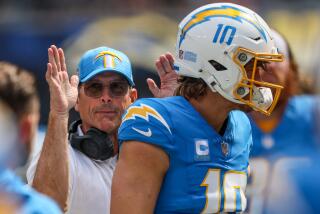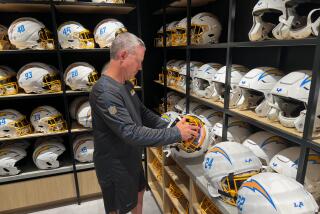LADLE OF FOOTBALL : They Don’t Produce Much Steel in Western Pennsylvania, but They Still Turn Out Outstanding Athletes
- Share via
PITTSBURGH — Dan Marino threw his first pass here. Bill Fralic threw his first block here. Just a few miles up the Ohio River, Tony Dorsett threw his first fake--and Mike Ditka threw his first temper tantrum.
Pittsburgh may have lost its status as steelmaker for the world, and most of its stereotypical, broad-shouldered coal miners and steelworkers abandoned the open hearths and mines years ago.
The seven-mile-long mills that once forged countless tons of steel have rusted into mini-ghost towns or been renovated into look-alike industrial parks. The character of Pittsburgh’s well-known ethnic communities has changed as white-collar workers in high-tech industries move into the homes where millwrights and pipe fitters once lived.
But while Pittsburgh may have lost its steel business to Japan and thousands of residents to states such as Florida where jobs are plentiful, one thing hasn’t changed.
Football.
Jim Kelly’s home is in nearby East Brady. Dan Marino grew up just a few blocks from the University of Pittsburgh’s campus, Dorsett and Fralic and Johnny Unitas just a few miles away. Joe Montana played high school football in the Mon Valley, Mike Ditka, Joe Namath and Dorsett in the Beaver Valley, Lou Holtz grew up in the Ohio Valley.
And five of the NFL’s 28 head coaches--Marty Schottenheimer, Frank Gansz, Chuck Knox, Joe Walton and Ditka--drew their first Xs and Os here. If Miami of Ohio is college football’s cradle of coaches, Pittsburgh is its pro football equivalent.
Pittsburgh and its surrounding hillside and river valley towns, with easily-recognizable names such as Aliquippa and Beaver Falls and Mount Lebanon and McKees Rocks, are dotted with factories of every shape and size. And as a football factory, Pittsburgh may have no equal.
“The people are proud and tough and they love their football,” said Schottenheimer, a native of McDonald, Pa. “I can look up in the stands at Browns-Steelers games and see some of the same people I saw at high school games.”
“Football is important in Pittsburgh,” said Fralic, the Atlanta Falcons’ All-Pro guard and a three-time All-American at Pitt. “I mean, everybody cares about the Steelers . . . that’s all you hear in football season. All of the local communities take pride in their high school football teams. I played before some bigger crowds in high school (Penn Hills) than some guys did in college.”
Because Pittsburgh is a collection of tight-knit communities rather than a faceless, egocentric megalopolis, residents loyally support their local high school football teams for years after they’ve graduated--and years after their children have graduated.
Pop Warner and pee wee leagues expose players as young as 7 to football, and thousands continue to play the sport into high school and college. When fall comes to western Pennsylvania, there’s little distraction--no beaches, no surfing, just football.
“For any college coach recruiting east of the Mississippi, a visit to western Pennsylvania is mandatory,” said Doug Huff, a Wheeling, W.Va., sportswriter who publishes a well-known college recruiting newsletter.
“There’s so much individual talent there that a coach is more likely to take a gamble on a questionable western Pennsylania player than he is one from almost any other area. The track record is there.”
Pitt, Penn State, Notre Dame, Ohio State and West Virginia have tapped western Pennsylvania talent for years. Need a lineman? Go to western Pennsylvania. Need a linebacker? Go to western Pennsylvania. Need a quarterback? Go to western Pennsylvania.
Division II powers Edinboro, Clarion, Slippery Rock and Indiana (Pa.) do almost all of their recruiting locally. Washington & Jefferson College was one of the NCAA’s top-ranked Division III teams last fall. USA Today’s national scholastic champion was suburban Pittsburgh’s unbeaten North Hills High School, whose first-team defense didn’t allow a point all season.
“You don’t see as many skilled position players coming out of there as before, and there hasn’t been a great quarterback since Kelly and Marino,” Huff said. “If a coach wants a great wide receiver or running back, he goes to Florida or Texas or California. You can run track in Florida 12 months a year.
“But while the kids in Florida are running track, the players in western Pennsylvania are lifting weights or wrestling. In western Pennsylvania football, strength and skill are bigger factors than flat-out speed.”
“Some places, all the kids talk about is how fast they run the 40,” Fralic said. “In Pittsburgh, all the kids talk about how much they can bench press.”
Because of the attention football receives, some coaches believe western Pennsylvania players develop their intensity and dedication to the sport years ahead of those in other states. Ditka is a perfect example.
“He was always the way he is now,” said Don Yannessa, Aliquippa’s coach and Ditka’s high school teammate. “There was never anything phony about his intensity. When Vince Lombardi said, ‘Winning isn’t everything, it’s the only thing,’ he had guys like Mike in mind.”
Dan Marino Sr. and Joe Montana Sr. said they never had to push their famous quarterback sons into football. In W-Pa, as its called, every good athlete is expected to play football without prodding.
“If anything, Joe pushed me,” Montana said. “When I’d get home from work, he’d be standing there waiting on me, a ball in his hand, ready to throw.”
“I never pushed football on Danny,” Marino said. “Football has always been the No. 1 thing in his life.”
Maybe it’s because football is a way of life in western Pennsylvania.
More to Read
Go beyond the scoreboard
Get the latest on L.A.'s teams in the daily Sports Report newsletter.
You may occasionally receive promotional content from the Los Angeles Times.










